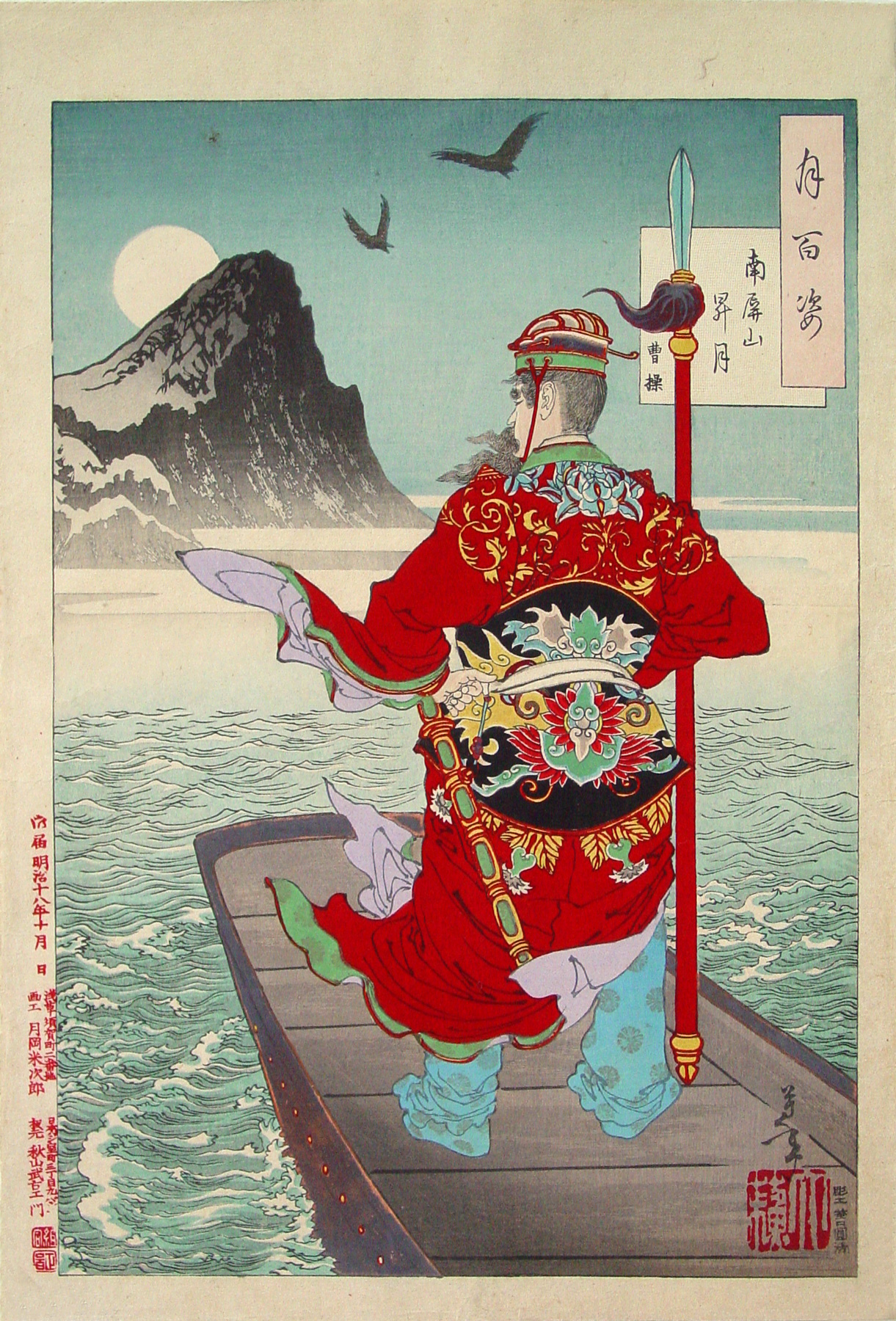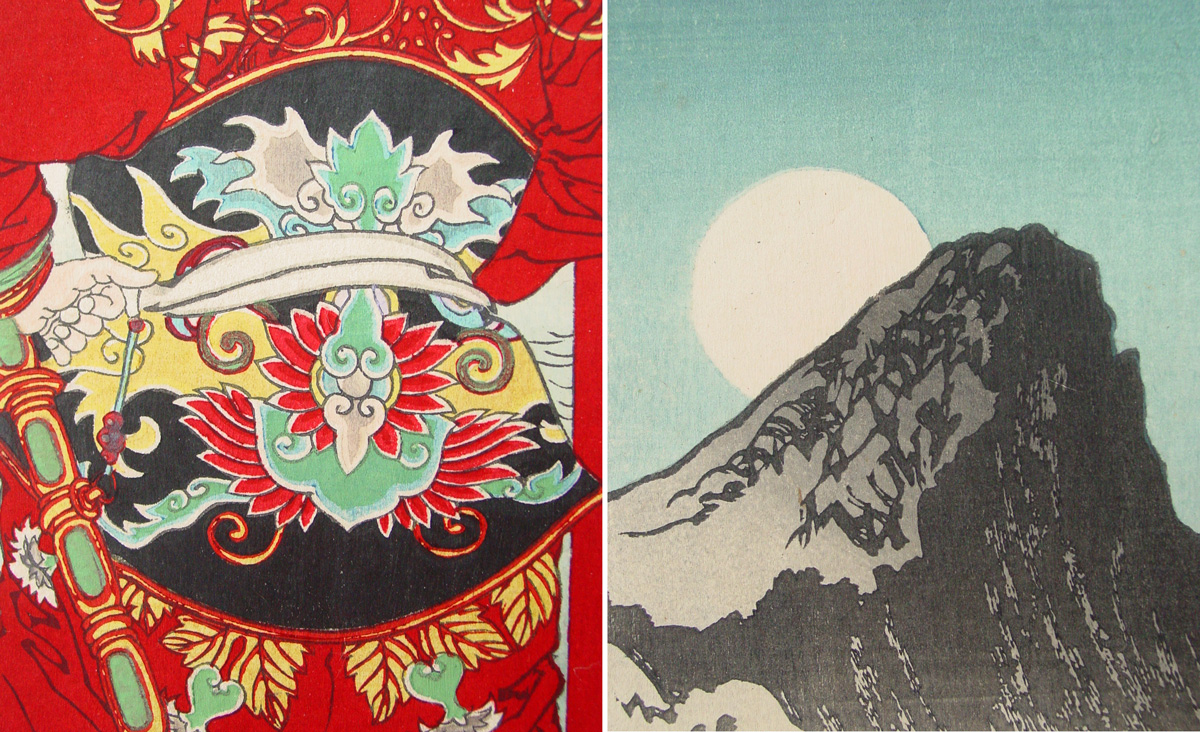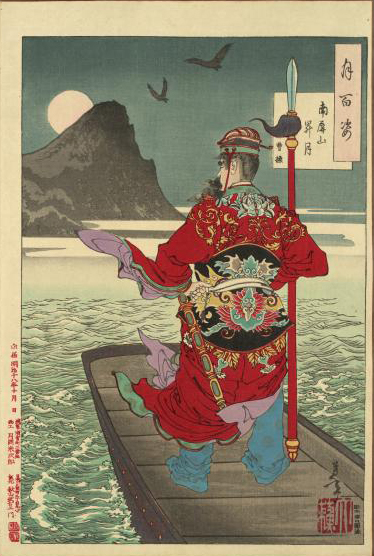About This Print
Source: Museum of International Folk Art http://www.internationalfolkart.org/exhibitions/past/moonweb/section1/001.htm
On the night before the battle of Zhang Jiang, the Chinese leader Cao Cao (A.D. 155-200) called his generals to his ship for a banquet. As the moon rose, he composed a poem to celebrate their gathering.
An early, if not first, state of this print.
The Story Depicted in the Print as Told by John Stevenson
Source: Yoshitoshi's One Hundred Aspects of the Moon, John Stevenson, Hotei Publishing, Netherlands 2001.3.
Rising Moon Over Mount Nanping – Cao Cao
Nanpeizan shōgetsu - Sōsō
Nanpeizan shōgetsu - Sōsō
A famous episode in the semi-historical San guo yan yi, Romance of the Three Kingdoms, forms the basis for this design. Written in the fourteenth century, the Romance is still widely read in China today. The story unfolds during the civil wars of early third century China, when the Han empire was breaking up into three separate kingdoms.
The major character in the story is Cao Cao, in Japanese Sōsō. The son of a low ranking solider, Cao Cao rose to prominence when he put down a rebellion of the Yellow Turbans in the Year 184. Having expelled them from Shandong province in northeastern China, he proceeded to make the area a power-base from which he attempted to become emperor himself – he was successful to the extent that one his sons became the first emperor of the Wei dynasty. He ruthlessly removed anyone who stood in his way, and his life was one of constant treachery and intrigue. Though he is the villain of the Romance, he is portrayed as a brave and forceful man, at least as attractive as many of the heroes of the story.
Cao Cao is crossing the Yangzi river on the night before the decisive Battle of the Red Cliffs. He stands in the prow of a boat at the head of 830,000 troops, in full, though anachronistic, Chinese military regalia – Yoshitoshi has captured his powerful stance very well. A following breeze stirs his robes, and mists swirl over the river. The moon rises over the distant cliffs; two crows fly overhead.
The Romance describes Cao Cao on the eve of the great battle at a banquet with his generals. He hears crows cawing and asks why they are making such an inauspicious noise in the middle of the night. He is told that they cannot sleep because of the brightness of the full moon. Cao Cao is slightly drunk and brushes off the ill omen. He defiantly brandishes the great spear which he grasps in this design, boasting that it has subdued all his enemies so far, and will do so again. One of his officers contradicts him, suggesting that caution would be wise in their present circumstances. Cao Cao immediately kills him, and the banquet breaks up gloomily. He then gives orders for the impending battle, in which he is defeated.
Most educated Japanese in Yoshitoshi’s time would have been familiar with this chapter from Chinese literature. Over the centuries, a great many Chinese stories had been incorporated into Japanese culture, and Yoshitoshi devotes nearly a fifth of the One Hundred Aspects of the Moon to Chinese subjects. He illustrates the Battle of the Red Cliffs again in the series, showing a poet who eight hundred years later visited the site of the battle, where he composed one of China’s most famous poems.
Cao Cao’s name in the title cartouche is written appropriately in square, classical Chinese characters. In China a phrase meaning “Speak of Cao Cao, and Cao Cao comes” is a close equivalent of the English “Speak of the devil…”
About the Series "One Hundred Aspects of the Moon"For details about this series which consists of one hundred prints with the moon as a unifying motif, see the article on this site Yoshitoshi, One Hundred Aspects of the Moon.
Print Details
| IHL Catalog | #54 |
| Title | Rising Moon Over Mount Nanping – Cao Cao (Napeizan Shogetsu - Sōsō 南屏山昇月 曹操) |
| Series | One Hundred Aspects of the Moon (Tsuki hyaku sugata 月百姿) |
| John Stevens Reference No.* | 3 |
| Artist | Tsukioka Yoshitoshi (1839-1892) |
| Signature | Yoshitoshi 芳年 |
| Seal | Taiso 大蘇 |
| Date | October 1885 (御届明治十八年十月 日) |
| Edition | A single sheet issue, not bound into an album. An early state of the print. |
| Publisher | Akiyama Buemon (秋山武右エ門) [Marks: seal 26-132; pub. ref. 005] |
| Carver | Chōkō Noguchi Enkatsu 彫工埜口円活 |
| Impression | excellent |
| Colors | excellent |
| Condition | excellent - minor overall toning; very minor marks and flaws |
| Genre | ukiyo-e |
| Miscellaneous | |
| Format | oban |
| H x W Paper | 14 1/2 x 9 7/8 in. (36.8 x 25.1 cm) |
| H x W Image | 13 x 8 7/8 in. (33 x 22.5 cm) |
| Collections This Print | Yale University Art Gallery 2011.143.1.3; The British Museum 1906,1220,0.1427; Tokyo Metropolitan Library 加4722-5; Hagi Uragami Museum (Yamaguchi, Japan) UO1507; The Tsubouchi Memorial Theatre Museum of Waseda University 201-4491; Ritsumeikan University ARC NDL-541-00-006 |
| Reference Literature | * Yoshitoshi’s One Hundred Aspects of the Moon, John Stevenson, Hotei Publishing, Netherlands 2001, pl. 3. |




